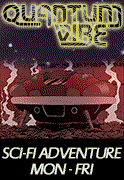|
Strip 618 -- First Seen: 2011-01-19
Escape From Terra is updated with new pages every Monday through Friday.
Kickstarter Success!
The Not-Safe-Space 2 Kickstarter Campaign has ended successfully. Thanks to all who pledged!
Now we get to wait 2 weeks while Kickstarter transmits the funds, and Scott can order the books, and send surveys to backers to get current e-mail addresses for the .PDF versions and mailing addresses for the physical books.
All of this should show up in June.
The Transcript For This Page
Panel 1
Square panel. An outer-space scene: The Delta-Free is approaching the tiny Martian moon Phobos. Phobos is airless, cratered, and not quite spherical. It is roughly 22 kilometers across, on average.
The ship is still about 50 kilometers away from Phobos. Mars herself is spread wide across the background, about 5400 kilometers below (or maybe above) Phobos. Since Mars' diameter is a bit less than 6800 km, she won't fit in the frame, but shows a very strong horizon curvature.
Caption: Because burners are not built to land directly on planetary bodies, passengers must use either of two systems to descend to the surface of Mars: The Barsoom Skyhook or the Gassend Space Elevator.
Panel 2
A closer-up view of Phobos where we can clearly see the Stickney Crater. A few bright lights can be seen within the crater's shadows – there is a network of spaceship moorings and tube-trains leading to the upper end of the Barsoom Skyhook. We see its ribbon extending from the rim of the crater, angling towards us (and to Mars, which is behind us in this frame). We can see a Crawler (something about the size of a 727 jet aircraft, with a fatter body and its wings folded upward, beginning its descent along the cable.
Caption: The Barsoom Skyhook is tethered on the rim of Stickney Crater on Phobos. Burners are moored inside the crater and passengers transferred to the Skyhook via tube trains.
Caption: The Skyhook passes over any given point along the Martian Equator roughly every 45 centimes, or 11.1 Terran hours.
Panel 3
Here we see the lower end of the Skyhook, which is moving through the Martian Sky about 100 kilometers above the surface, at the upper reaches of the thin atmosphere. There is a bit of wind resistance, causing the ribbon to curve a bit towards its bottom end. At the bottom is a mooring structure about the size of a railroad box-car with robot arms, currently held in close to its sides. Here we see the Crawler, now with wings extended, flying away from just above the mooring structure . It drops a bit at first and then levels off under rocket power.
Caption: At the lower end, the Crawler spreads its wings, casts off and flies to the surface like an airplane.
|
|





















